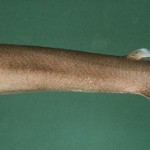 GUADELUPE ISLAND (MEXICO)- Researchers have for the first time found hard evidence that the small cookiecutter sharks go after one of the world’s most fearsome predators, the great white.
GUADELUPE ISLAND (MEXICO)- Researchers have for the first time found hard evidence that the small cookiecutter sharks go after one of the world’s most fearsome predators, the great white.
One of the world’s smallest sharks, they have been known to prey on a wide variety of marine animals, including swordfish, whales, orcas and even a human swimmer . Unlike their bigger cousins the cookiecutter sharks don’t kill their prey, they just take a bite and move on.
Divers in a shark tank off of Guadalupe Island, which is about 150 miles (240 kilometers) west of Mexico’s Baja California peninsula, took a photograph of a great white sporting a fresh bite from a cookiecutter, as documented in a study published recently in the journal Pacific Science. It’s the first photographic evidence of such a bite, said study author Yannis Papastamatiou, a marine biologist at the Florida Museum of Natural History.
Cookiecutter sharks leave a very distinctive scar when they bite; their specialized jaw allows them to “scoop out a hemispherical plug of flesh from their prey,” according to the study.
The sharks’ name comes from the uniformity of the bite, which looks “like you took a cookie cutter to some dough,” The cookiecutter shark (Isistius brasiliensis) can grow up to 20 inches (50 centimeters) long, while great whites can reach lengths of nearly 20 feet (6 meters), according to the International Union for Conservation of Nature. Cookiecutter sharks range throughout the world in tropical and subtropical waters. They often dive during the day and come near the surface at night. One specimen was caught at a depth of 9,840 feet (3,000 meters).
Read more and see the photos of the bitemarks at MSNBC.
